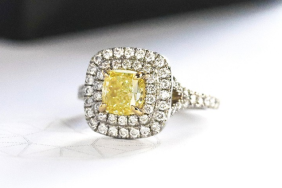“He helped design the ring.”
This sentence tends to set me off. The increasingly popular notion that the average guy, purely by virtue of his desire to pop the question, is magically transformed into a jewelry designer. Ask the guy you’re casually dating to venture into a jewelry store, and chances are he’ll break into a cold sweat. But once he’s made the decision to spring for a diamond, suddenly, he must be imbued with the ability to not only speak intelligently about galleries, shanks and mountings, shoulders, bezels and underbezels, but also has achieved some modicum of artistic flair to create an engagement ring that couldn’t otherwise be conceived by, you know, someone who designs them for a living. Don’t guys just point to ready-made rings in glass cases anymore?
Then again, the average guy isn’t George Clooney, amirite?
I realize I sound a little cranky on the topic, but honestly, the coverage of Clooney’s engagement to UK lawyer Amal Alamuddin has been more than a little breathless, especially with regard to the ring. And while the sparkler is indeed quite beautiful—an emerald-cut diamond estimated at 7 carats, flanked by two tapered baguettes and set in platinum—can we all at least agree it doesn’t exactly represent a quantum leap in ring design?
There’s a great scene in 1995’s To Die For, in which Illeana Douglas, as Janice Maretto, discusses her feelings about Nicole Kidman’s character, Suzanne, who designed the rings for her wedding to Janice’s brother, Matt Dillon as Larry Maretto: “Larry, he was so proud, you know, ‘cause Suzanne designed the wedding rings all by herself. You want me to describe them for you? They were round and gold. I mean, big f**kin’ deal.”
Every single time we’re deluged with frenzied reportage of a male celeb who designed something round and gold (or, in this case, platinum), I think of this scene. Brad Pitt garnered coverage as a “co-designer” twice, first with Silvia Damiani for his ring for Jennifer Aniston (Pitt later partnered with Damiani on a full-on wedding band collection. Hint: they were round and also…gold!), and then again with Robert Procop for Angelina Jolie’s ring. When did he find the time to make World War Z?
And, of course, because it’s Clooney, there’s an added element, prominently positioned within the first sentence in most of the stories you’ve read this week: the diamond was ethically mined. Such a detail makes sense when you combine Clooney’s well-documented activism in Darfur and South Sudan with Alamuddin’s work as a human rights attorney. For the uninitiated, “ethically mined” means the diamond was likely sourced outside those violence-ridden regions in which conflicts are widely thought to be financed by the sale of stones that have come to be known as “blood” diamonds. The mining doesn’t employ child labor or any other form of worker exploitation, and the stone was excavated by a method that did not impact the environment in any negative way.
In 2003, a certification for conflict-free diamonds, known as the Kimberley Process, was created. And while we should eagerly support these philosophies, you will find environmentalists and political activists who have called into question the reliability of the Kimberley Process, noting that it’s a morass of ethical issues and legal loopholes. It’s also important to note that “ethically mined” and Kimberley Process certification aren’t synonymous; it’s actually a huge conversation that can’t simply be glossed over with a passing mention from your publicist.
Indeed, among the many comment boards out there dishing on the Clooney diamond (I’ve decided to just call it that from now on, like the Hope or the Tiffany Yellow), a few observers have astutely pointed out that if you wanted to really embrace the most eco-conscious choice, why not go with an antique ring? Alamuddin strikes us as a stylish woman, and vintage rings are becoming increasingly popular (not to mention, they’re the most eco-friendly option, as they require no mining), so perhaps she would have been into a Victorian or Edwardian-era ring with its own romantic backstory?
But no, Clooney was likely welcomed into a private room—or, just as likely, a briefcase of stones was brought to him—and he pointed to something he liked as an exceptionally educated jeweler explained a variety of details on cut, carat weight, clarity, etc., and decisions were made from there. But this does not a ring designer make.
When I mentioned this on Facebook earlier this week, a colleague chimed in, “Hey, it’s a gorgeous ring!” I don’t deny that for a second. It’s chicly simple and ultra-classic—so ultra-classic, in fact, that it distinctly reminds me of perhaps the most captivating engagement ring of all time: the 10.47-carat emerald-cut diamond, flanked by baguettes and set in platinum, designed by Cartier and commissioned by Prince Rainier to present to Grace Kelly in 1956.
No jewelry house has taken credit for the Clooney—no surprise, given the feverish press and the typical reticence among jewelers when it comes to dishing details on celeb clients—but it wouldn’t surprise me if Cartier likewise recreated the diminutive skating rink now residing on Alamuddin’s left hand. Clooney, after all, is a guy who embraces the classic glamour of old Hollywood—his Los Angeles home was once owned by Clark Gable. It would feel quite natural if he reached out to a classic jewelry house, and the design of Kelly’s ring was used as a jumping off point. (On a side note, if you ever want to enjoy both a good look and a wink at Kelly’s ring, check out 1956’s High Society, her last film before becoming a bona fide princess, in which she wears her IRL sparkler. Conveniently, you can catch it today on Turner Classic Movies at 12:30 p.m. ET.)
Listen, I’m all for a guy being involved in the look of the ring he’ll present to seal the deal. But there’s an abyss of difference between “being involved” and headlines or lead paragraphs that trumpet your mad skillz as a ring designer. Such positioning does a disservice to those who have devoted their lives to this highly intricate, exhaustive craft. And honestly, we’d still love Clooney just as much if he admitted that he pointed to a ring in a glass case, wouldn’t we? Because ultimately, love springs eternal—just as we once thought about his bachelorhood.






